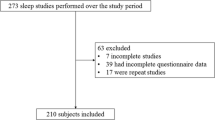Abstract
Purpose
Obstructive sleep apnea (OSA) remains underdiagnosed, despite our understanding of its impact on general health. Current screening methods utilize either symptoms or physical exam findings suggestive of OSA, but not both. The purpose of this study was to develop a novel screening tool for the detection of OSA, the NAMES assessment (neck circumference, airway classification, comorbidities, Epworth scale, and snoring), combining self-reported historical factors with physical exam findings.
Methods
Subjects were adults without previously diagnosed OSA, referred to a community sleep center for suspicion of OSA. General health, Epworth Sleepiness Scale (ESS), and Berlin questionnaires were completed, and a physical exam focusing on modified Friedman (MF) grade, body mass index (BMI), and neck circumference (NC) was performed prior to polysomnography. OSA was defined by a respiratory disturbance index ≥15. Each variable was dichotomized, and cutoff values were determined for the NAMES tool in a pilot group of 150 subjects. The NAMES score was calculated from NC, MF, comorbidities, ESS, and loud snoring values. The performances of the NAMES, Berlin questionnaire, and ESS screening tests in predicting OSA were then compared in a validation group of 509 subjects.
Results
In the pilot population, the cutoff value for the composite NAMES tool was calculated at ≥3 points. In the validation group, NAMES demonstrated similar test characteristics to the Berlin questionnaire, and sensitivity was better than that seen with the Epworth scale. The addition of BMI and gender to the tool improved screening characteristics.
Conclusions
The NAMES assessment is an effective, inexpensive screening strategy for moderate to severe OSA.



Similar content being viewed by others
References
Punjabi NM, Caffo BS, Goodwin JL, Gottlieb DJ, Newman AB, O’Connor GT, Rapoport DM, Redline S, Resnick HE, Robbins JA, Shahar E, Unruh ML, Samet JM (2009) Sleep-disordered breathing and mortality: a prospective cohort study. PLoS Med 6:e1000132
Nieto FJ, Young TB, Lind BK, Shahar E, Samet JM, Redline S, D’Agostino RB, Newman AB, Lebowitz MD, Pickering TG (2000) Association of sleep-disordered breathing, sleep apnea, and hypertension in a large community-based study. Sleep Heart Health Study. JAMA 283:1829–1836
Punjabi NM, Shahar E, Redline S, Gottlieb DJ, Givelber R, Resnick HE, Sleep Heart Health Investigators (2004) Sleep-disordered breathing, glucose intolerance, and insulin resistance: the Sleep Heart Health Study. Am J Epidemiol 160:521–530
Chami HA, Devereux RB, Gottdiener JS, Mehra R, Roman MJ, Benjamin EJ, Gottlieb DJ (2008) Left ventricular morphology and systolic function in sleep-disordered breathing: the Sleep Heart Health Study. Circulation 117:2599–2607
O’Connor GT, Caffo B, Newman AB, Quan SF, Rapoport DM, Redline S, Resnick HE, Samet J, Shahar E (2009) Prospective study of sleep-disordered breathing and hypertension. Am J Respir Crit Care Med 179:1159–1164
Redline S, Yenokyan G, Gottlieb DJ, Shahar E, O’Connor GT, Resnick HE, Diener-West M, Sanders MH, Wolf PA, Geraghty EM, Ali T, Lebowitz M, Punjabi NM (2010) Obstructive sleep apnea–hypopnea and incident stroke: the Sleep Heart Health Study. Am J Respir Crit Care Med 182:269–277
George CF, Boudreau AC, Smiley A (1997) Effects of nasal CPAP on simulated driving performance in patients with obstructive sleep apnoea. Thorax 52:648–653
Turkington PM, Sircar M, Allgar V, Elliott MW (2001) Relationship between obstructive sleep apnoea, simulated driving performance, and risk of road traffic accidents. Thorax 56:800–805
Pichel F, Zamarrón C, Magán F, Rodríguez JR (2006) Sustained attention measurements in obstructive sleep apnea and risk of traffic accidents. Respir Med 100:1020–1027
Pang KP, Terris DJ (2006) Screening for obstructive sleep apnea: an evidence-based analysis. Am J Otolaryngol 27:112–118
Hallowell PT, Stellato TA, Schuster M, Graf K, Robinson A, Crouse C, Jasper JJ (2007) Potentially life-threatening sleep apnea is unrecognized without aggressive evaluation. Am J Surg 193:364–367
Johns MW (1991) A new method for measuring daytime sleepiness: the Epworth Sleepiness Scale. Sleep 14:540–545
Johns MW (1993) Daytime sleepiness, snoring, and obstructive sleep apnea. The Epworth Sleepiness Scale. Chest 103:30–36
Netzer NC, Stoohs RA, Netzer CM, Clark K, Strohl KP (1999) Using the Berlin questionnaire to identify patients at risk for the sleep apnea syndrome. Ann Intern Med 131:485–491
Friedman M, Tanyeri H, La Rosa M, Landsberg R, Vaidyanathan K, Pieri S, Calderelli D (1999) Clinical predictors of obstructive sleep apnea. Laryngoscope 109:1901–1907
Davies RJ, Stradling JR (1990) The relationship between neck circumference, radiographic pharyngeal anatomy, and the obstructive sleep apnoea syndrome. Eur Respir J 3:509–514
Iber C, Ancoli-Israel S, Chesson A, Quan S (2007) The AASM manual for the scoring of sleep and associated events: rules, terminology, and technical specifications, 1st edn. American Academy of Sleep Medicine, Westchester
Surani S, Aguillar R, Aguillar R, Subramanian S (2010) Standardization of quality assurance for technologist: a model. Sleep Breath 14:3–12
BMI classification (2010) World Health Organization. http://apps.who.int/bmi/index.jsp?introPage=intro_3.html. Accessed 10 July 2010
Friedman M, Wilson MN, Pulver T, Pandya H, Joseph NJ, Lin HC, Chang HW (2010) Screening for obstructive sleep apnea/hypopnea syndrome: subjective and objective factors. Otolaryngol Head Neck Surg 142:531–535
Collop NA, Anderson WM, Boehlecke B, Claman D, Goldberg R, Gottlieb DJ, Hudgel D, Sateia M, Schwab R, Portable Monitoring Task Force of the American Academy of Sleep Medicine (2007) Clinical guidelines for the use of unattended portable monitors in the diagnosis of obstructive sleep apnea in adult patients. Portable Monitoring Task Force of the American Academy of Sleep Medicine. J Clin Sleep Med 3:737–747
Conflict of interest
The authors declare that they have no conflict of interest.
Author information
Authors and Affiliations
Corresponding author
Rights and permissions
About this article
Cite this article
Subramanian, S., Hesselbacher, S.E., Aguilar, R. et al. The NAMES assessment: a novel combined-modality screening tool for obstructive sleep apnea. Sleep Breath 15, 819–826 (2011). https://doi.org/10.1007/s11325-010-0443-3
Received:
Revised:
Accepted:
Published:
Issue Date:
DOI: https://doi.org/10.1007/s11325-010-0443-3




